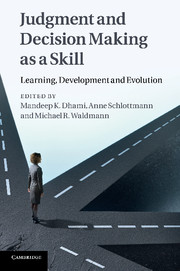23 results
Representative design: A realistic alternative to (systematic) integrative design
-
- Journal:
- Behavioral and Brain Sciences / Volume 47 / 2024
- Published online by Cambridge University Press:
- 05 February 2024, e48
-
- Article
- Export citation
Kenneth R. Hammond’s contributions to the study of judgment and decision making
-
- Journal:
- Judgment and Decision Making / Volume 13 / Issue 1 / January 2018
- Published online by Cambridge University Press:
- 01 January 2023, pp. 1-22
-
- Article
-
- You have access
- Open access
- HTML
- Export citation
Evolution of the interpersonal conflict paradigm
-
- Journal:
- Judgment and Decision Making / Volume 3 / Issue 7 / October 2008
- Published online by Cambridge University Press:
- 01 January 2023, pp. 547-569
-
- Article
-
- You have access
- Open access
- HTML
- Export citation
How do defendants choose their trial court? Evidence for a heuristic processing account
-
- Journal:
- Judgment and Decision Making / Volume 8 / Issue 5 / September 2013
- Published online by Cambridge University Press:
- 01 January 2023, pp. 552-560
-
- Article
-
- You have access
- Open access
- HTML
- Export citation
Boosting intelligence analysts’ judgment accuracy: What works, what fails?
-
- Journal:
- Judgment and Decision Making / Volume 13 / Issue 6 / November 2018
- Published online by Cambridge University Press:
- 01 January 2023, pp. 607-621
-
- Article
-
- You have access
- Open access
- HTML
- Export citation
Male Youth Perceptions of Violent Extremism: towards a Test of Rational Choice Theory
-
- Journal:
- The Spanish Journal of Psychology / Volume 19 / 2016
- Published online by Cambridge University Press:
- 20 September 2016, E51
-
- Article
- Export citation
Spanish Young Adults' Perceptions of the Costs and Benefits of Risky Driving Behaviors
-
- Journal:
- The Spanish Journal of Psychology / Volume 15 / Issue 2 / July 2012
- Published online by Cambridge University Press:
- 10 January 2013, pp. 638-647
-
- Article
- Export citation
Part IV - Improving and aiding JDM
-
- Book:
- Judgment and Decision Making as a Skill
- Published online:
- 05 December 2011
- Print publication:
- 01 December 2011, pp 227-228
-
- Chapter
- Export citation
Conclusion
-
- Book:
- Judgment and Decision Making as a Skill
- Published online:
- 05 December 2011
- Print publication:
- 01 December 2011, pp 289-290
-
- Chapter
- Export citation
Chapter cross-reference table
-
- Book:
- Judgment and Decision Making as a Skill
- Published online:
- 05 December 2011
- Print publication:
- 01 December 2011, pp xv-xvi
-
- Chapter
- Export citation
Frontmatter
-
- Book:
- Judgment and Decision Making as a Skill
- Published online:
- 05 December 2011
- Print publication:
- 01 December 2011, pp i-iv
-
- Chapter
- Export citation
Part I - Evolutionary and neural bases of JDM
-
- Book:
- Judgment and Decision Making as a Skill
- Published online:
- 05 December 2011
- Print publication:
- 01 December 2011, pp 1-2
-
- Chapter
- Export citation
Contributors
-
- Book:
- Judgment and Decision Making as a Skill
- Published online:
- 05 December 2011
- Print publication:
- 01 December 2011, pp ix-xi
-
- Chapter
- Export citation
Part III - Learning JDM
-
- Book:
- Judgment and Decision Making as a Skill
- Published online:
- 05 December 2011
- Print publication:
- 01 December 2011, pp 141-142
-
- Chapter
- Export citation
Acknowledgments
-
- Book:
- Judgment and Decision Making as a Skill
- Published online:
- 05 December 2011
- Print publication:
- 01 December 2011, pp xiv-xiv
-
- Chapter
- Export citation
Index
-
- Book:
- Judgment and Decision Making as a Skill
- Published online:
- 05 December 2011
- Print publication:
- 01 December 2011, pp 307-311
-
- Chapter
- Export citation
11 - Perspectives on judgment and decision making as a skill
-
-
- Book:
- Judgment and Decision Making as a Skill
- Published online:
- 05 December 2011
- Print publication:
- 01 December 2011, pp 291-306
-
- Chapter
- Export citation
Figures
-
- Book:
- Judgment and Decision Making as a Skill
- Published online:
- 05 December 2011
- Print publication:
- 01 December 2011, pp vii-viii
-
- Chapter
- Export citation

Judgment and Decision Making as a Skill
- Learning, Development and Evolution
-
- Published online:
- 05 December 2011
- Print publication:
- 01 December 2011
Preface
-
-
- Book:
- Judgment and Decision Making as a Skill
- Published online:
- 05 December 2011
- Print publication:
- 01 December 2011, pp xii-xiii
-
- Chapter
- Export citation



